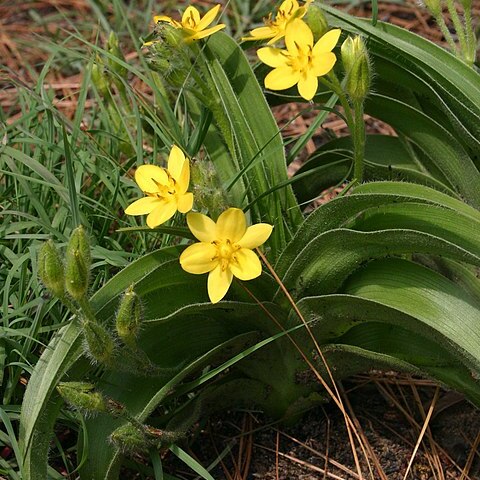Perennial geophyte, robust, 100-600 mm high; rhizome with strong fibrous tunic. Leaves 8-12, arranged one above the other in 3 ranks, lanceolate or linear-lanceolate, 200-500 x 18-25 mm, sickle-shaped, recurving, veins flush with surface, with an even distribution of hairs, mainly on lower surface and in young leaves, less hairy with age. Flowers 4-12, yellow; tepals 12-20 x 4-7 mm; anther apex entire or split; ovary 3-4 mm long; style shorter than stigma. Flowering time (Aug.) Sept.-Mar. (-May.
Leaves 7–16, ternate, conduplicate at least towards the base, arcuate and gradually tapering to a narrowly acute apex, imbricately overlapping at the base; lamina 10–60 × 1.4–4.8 cm, finely many-ribbed, strigose or sericeous-pubescent on the abaxial (lower) surface, sparsely so or glabrescent on the adaxial (upper) surface, the hairs mostly 2-armed with the arms appressed-strigose or ± strongly curled; pseudostem absent.
Outer tepals 12–20 × 4–8 mm, lanceolate-elliptic, coriaceous, ± involute on the margins, ± densely strigose-sericeous outside; inner tepals 12–18 × 8–11 mm, broadly elliptic to ovate, membranous, ± involute on the margins, glabrous or pubescent-sericeous on the abaxial midrib; the indumentum hairs unequally 3–6-armed (stellate) often with one arm strongly developed and up to c. 5 mm long.
Scapes up to c. 21(30) cm long, flattened in cross-section and up to c. 5 mm wide, densely strigose in upper part, sparsely so or glabrescent below, the hairs unequally 3–6-armed (stellate) with 1–2 arms strongly developed and directed to apex and base, or the hairs 2-armed.
Flowers 2–7(10) in a raceme-like arrangement 3–6(10) cm long; bracts 7–25(30) mm long, subulate to linear-lanceolate, pubescent to sericeous on the abaxial midrib; pedicels ascending, the lower ones 10–20(30) mm long, the upper decreasing in length.
Geophyte, up to 300 mm tall. Acaulescent with a large underground corm, crowned with a ring of bristles. Leaves distichous, 300 x 32 mm, strap-shaped, folded. Flowers yellow.
Rhizome stout, vertical 3–6(8) × 2.5–6(7) cm, turbinate to subglobose, or up to 14 × 4 cm and cylindrical, equatorially ringed by stout contractile roots.
Seeds black and glossy, 1.3 × 1.7–1.8 mm, ovoid; testa smooth or ± covered in dome-shaped undulations.
Filaments 1–3 mm long, triangular with membranous wings; thecae 4–8 mm long.
Capsule 5–8 mm long and 5–8 mm in diameter, turbinate, circumscissile.
Inflorescences 2–14, usually appearing with the leaves.
Style 1–1.5 mm long; stigma 2–4 mm long.
Robust perennial herb to 40 cm tall.

